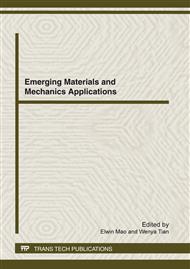p.7
p.11
p.15
p.20
p.24
p.29
p.33
p.38
p.43
Effect of Structure of Polycarboxylate Superplasticizer on Hydration of Cement in Early Period
Abstract:
Effect of polycarboxylate superplasticizer (PCs) with different bond between side chain and truck chain on hydration of cement in early period was studied. The performance of PCs in concrete was investigated by setting time, TGA and SEM. PC-based superplasticizer with ester bonding between side chain and truck chain. Although they had the proximate structure parameters in density of side chain and absorption group (carboxyl groups), the setting time of cement paste was significantly different when different PCs were employed in the preparation of cement. Decomposing of this bond in alkali environment may lead to a shorter setting time. On the other hand, same difference in hydration production was observed in early period hydration of cement paste when two different PCs was incorporated, which indicated that the different bond structure in PCs affected the hydration of cement in a different manner. The result of SEM indicated that the morphological phase of hydrated product was different when PC was applied, this may be related with the different result in the TG and TGA
Info:
Periodical:
Pages:
24-28
Citation:
Online since:
March 2012
Authors:
Price:
Сopyright:
© 2012 Trans Tech Publications Ltd. All Rights Reserved
Share:
Citation:


